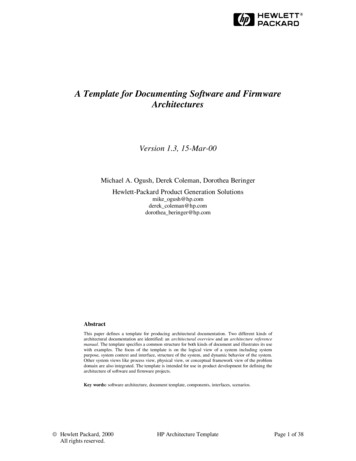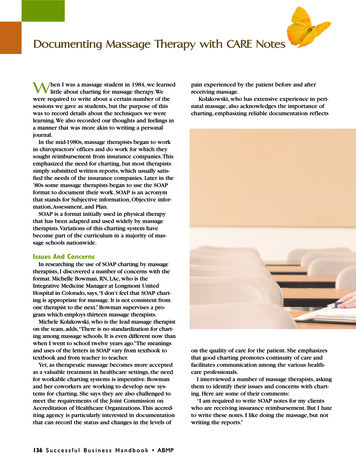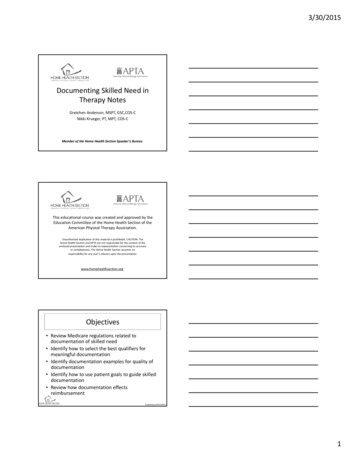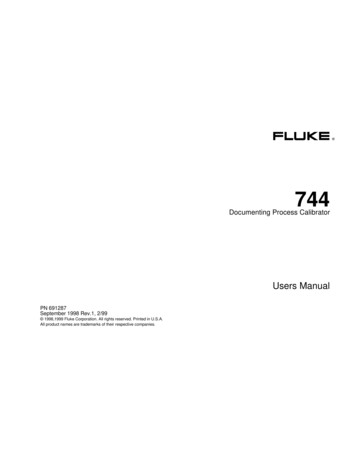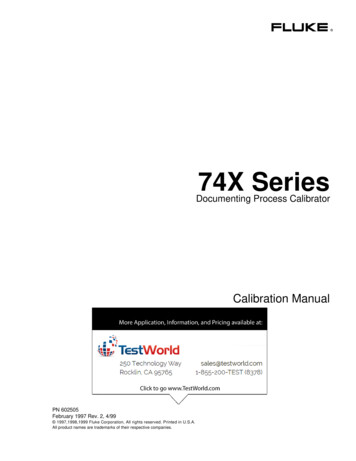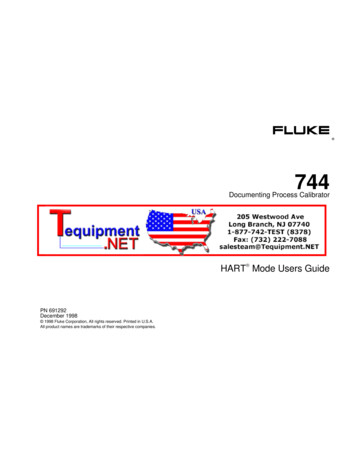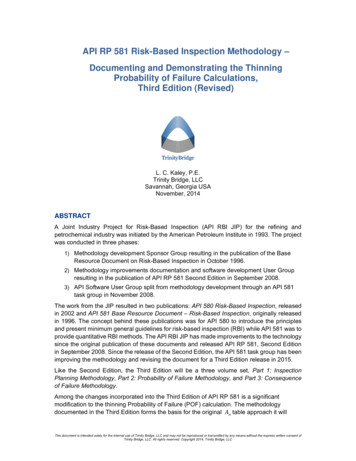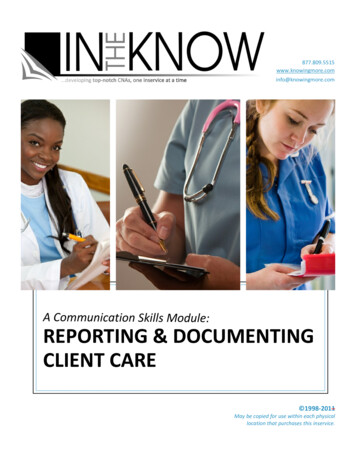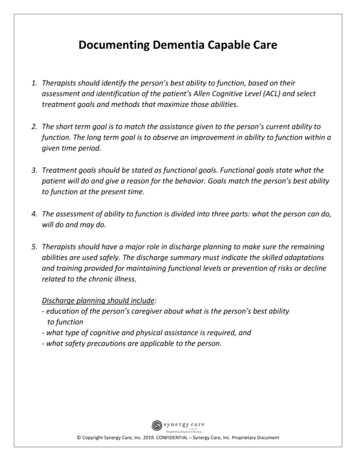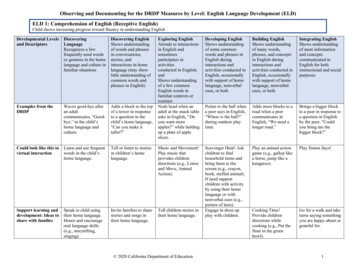![[Final] Documenting The University Of Pennsylvania’s .](/img/9/csgraubard-documenting-the-university-of-pennsylvanias-connection-to-slavery.jpg)
Transcription
Documenting the University of Pennsylvania’s Connection to SlaveryClay Scott GraubardThe University of Pennsylvania, Class of 2019April 19, 2018 2018 CLAY SCOTT GRAUBARD ALL RIGHTS RESERVED
DOCUMENTING PENN’S CONNECTION TO SLAVERY1Table of ContentsINTRODUCTION2OVERVIEW3LABOR AND CONSTRUCTION4PRIMER ON THE CONSTRUCTION OF THE COLLEGE AND ACADEMY OF PHILADELPHIAEBENEZER KINNERSLEY (1711 – 1778)ROBERT SMITH (1722 – 1777)THOMAS LEECH (1685 – 1762)BENJAMIN LOXLEY (1720 – 1801)JOHN COATS (FL. 1719)OTHERSLABOR AND CONSTRUCTION CONCLUSION5791113131315FINANCIAL ASPECTS17WEST INDIES FUNDRAISINGSOUTH CAROLINA FUNDRAISINGTRUSTEES OF THE COLLEGE AND ACADEMY OF PHILADELPHIA182531WILLIAM ALLEN (1704 – 1780) AND JOSEPH TURNER (1701 – 1783): FOUNDERS AND TRUSTEESBENJAMIN FRANKLIN (1706 – 1790): FOUNDER, PRESIDENT, AND TRUSTEEEDWARD SHIPPEN (1729 – 1806): TREASURER OF THE TRUSTEES AND TRUSTEEBENJAMIN CHEW SR. (1722 – 1810): TRUSTEEWILLIAM SHIPPEN (1712 – 1801): FOUNDER AND TRUSTEEJAMES TILGHMAN (1716 – 1793): TRUSTEENOTE REGARDING THE TRUSTEES31323334353536FINANCIAL ASPECTS CONCLUSION37CONCLUSION39THE UNIVERSITY OF PENNSYLVANIA’S CONNECTION TO SLAVERY40EXECUTIVE SUMMARY42BIBLIOGRAPHY43
DOCUMENTING PENN’S CONNECTION TO SLAVERYINTRODUCTION2
DOCUMENTING PENN’S CONNECTION TO SLAVERY3OverviewThe goal of this paper is to present the facts regarding the University of Pennsylvania’s (thenthe College and Academy of Philadelphia) significant connections to slavery and the slave trade. Thefirst section of the paper will cover the construction and operation of the College and Academy inthe early years. As slavery was integral to the economy of British North America, to fully understandthe University’s connection to slavery the second section will cover the financial aspects of theCollege and Academy, its Trustees, and its fundraising.To conduct this study, I did extensive research at: The Archives and Records Center of theUniversity of Pennsylvania (UARC), the Rare Books and Manuscripts department of the KislakCenter of the Van Pelt Library, The American Philosophical Society, The Historical Society ofPennsylvania, The Germantown Historical Society, The Old York Road Historical Society, TheCheltenham Museum, The Firestone Library and the University Archives at Princeton University,and the Christ Church of Philadelphia Archives. The bibliography only covers the documentsreferenced in the paper. In total during my research, I viewed at least double that number ofdocuments regarding Penn’s connection to slavery.Special thanks to the professional staff at the UARC for their guidance and support duringmy research.
DOCUMENTING PENN’S CONNECTION TO SLAVERYLABOR AND CONSTRUCTION4
DOCUMENTING PENN’S CONNECTION TO SLAVERY5Primer on the Construction of the College and Academy of PhiladelphiaIn 1750, Benjamin Franklin and the other trustees of the Academy purchased the “NewBuilding” on Fourth and Arch Streets. Originally, the owners of the building planned for it to beused as the center for George Whitefield’s preaching and also as a charity school. This was inresponse to the religious awakening that was jumpstarted by George Whitefield’s preaching in themid-eighteenth century. Construction of the building began in 1740 but was abandoned in 1741; itwas not finished until 1744. By 1747, a number of issues arose including the fading of evangelismand a growing number of repairs needed for the building.In 1749, Benjamin Franklin and a group of trustees decided to create an academy. AsBenjamin Franklin was a trustee for both the “New Building” and the Academy, he secured theselling of the property to what would become The College and Academy of Philadelphia. In 1750,the transfer of the property was complete.1Because the building was originally intended for religious purposes and to serve as a charityschool, the building was not suited for an academy. The College hired Edmund Woolley, JohnCoats, Benjamin Loxley, John Thornhill, and other tradesmen – many of whom were involved inthe initial construction of the “New Building” – to transform the building into a school.2The Academy received a charter and was renamed the College of Philadelphia in 1755. Asthe College grew, the building required more work. The Trustees hired the well-known architect andbuilder Robert Smith to perform alterations, constructions, and repairs. This work lasted untilroughly 1760. In 1761, the college hired Joseph Redman to do brickwork for the grounds.3Turner, William Lewis. 1952. "The College: Academy and Charitable School of Philadelphia; the Development of aColonial Institution of Learning, 1740-1779." PhD diss., University of Pennsylvania.2 Peterson, Charles Emil, Constance M. Grieff, and Maria M. Thompson. 2000. Robert Smith: Architect, Builder, Patriot,1722-1777.Philadelphia: Athenæum of Philadelphia.3 Ibid.1
DOCUMENTING PENN’S CONNECTION TO SLAVERY6In 1761, the College of Philadelphia needed a dormitory and they again turned to RobertSmith to design and build the dormitory. Smith designed his plans around two dormitories as it fithis intended style for the college. The Trustees, however, only wanted one building to beconstructed. The dormitory was finished in 1764. Change orders, however, regarding the dormitorywere given to Smith until the early 1770s.4In 1774, Provost William Smith of the College decided that he needed a house to be built forhis use on the campus grounds. The Trustees agreed to his proposal and once again turned to Smith.Robert Smith would design and construct the building which was finished in 1776, just one yearprior to his death.545Peterson, Grieff and Thompson, 2000Ibid.
DOCUMENTING PENN’S CONNECTION TO SLAVERY7Ebenezer Kinnersley (1711 – 1778)Ebenezer Kinnersley was a close friend of Benjamin Franklin and a collaborator withFranklin in his famous experiments on electricity. The Trustees appointed Kinnersley as theProfessor of English for the College and Academy of Philadelphia in 1753, and they named himSteward of the Dormitory in 1763, a position he held until leaving the Academy for health reasons in1772.On July 15, 1756, the minutes of the Trustees mentioned how the current usher was unableto ring the bell and make the fires, and that they would need a new usher to do so.The Master of the Charity School had formerly taken Care of these Things, and was alloweda small Sum for his Trouble, and it is now agreed that, though it might not be so proper forthe Head Master to do these Services, yet they might be done by the Usher without anyInconvenience; the present Usher therefore being Lame and incapable to take this uponhim it was recommended to procure a fit Person to succeed him, and on who will at thesame Time undertake the Charge of the Bell, make Fires and take Care of the Schools, tokeep them clean.6In October 1756, Kinnersley received his first payment from the University for the services of hisenslaved man to help ring the bell, prepare the fireplaces, and other heavy chores – appearing to be adirect response to the Trustees’ concerns raised in July.Kinnersley’s first payment for enslaved man’s services, 1756Coleman, William. 1749-1768. Trustees of the University of Pennsylvania Minute Books, Volume 1, 1749-1768 (College, Academyand Charitable School). Vol. 1. Philadelphia: University Archives and Records Center, University of Pennsylvania.6
DOCUMENTING PENN’S CONNECTION TO SLAVERY8Kinnersley continued to receive payments for his enslaved man’s service until January 16, 1770,which was the last time a mention of his enslaved man’s service was mentioned in the Day Book. Itis unclear why Kinnersley stopped receiving payments for his enslaved man’s service.Kinnersley’s enslaved man seemed to serve only the University and was paid 1 a month forhis services. In total, the College and Academy paid Kinnersley for his enslaved man’s services 15914s. 11d. (159 pounds, 14 shillings, 11 pence).Ebenezer Kinnersley did not own many slaves. On August 26, 1742 in the PennsylvaniaGazette, Kinnersley advertised a “Negro Woman, this country born ” for sale.7 Kinnersley and hiswife Sarah Duffield were given an enslaved woman Phillis in 1747 after Joseph Duffield, SarahDuffield’s father, passed away.8 Beyond that, it is known the Kinnersley owned only one enslavedindividual in 1767 and 1774 from the known tax lists – the enslaved man who provided services tothe College.9Kinnersley, Ebenezer. 1742. "TO BE SOLD, A Negro Woman, this Country born, who has been u." The PennsylvaniaGazette, August 26.8 1875. John Neill of Lewes, Delaware, 1739, and His Descendants. Philadelphia: Privately printed for the family.9 n.d. The particulars of each person’s estate, as appears by the township and ward assessors’ returns as follows [manuscript], by JacobUmstat, Barnaby Barnes, Andrew Bankson, John Roberts [?], Joseph Stamper, and Paul Engle Jun[ior], County Assessors.[Philadelphia], 1767.Ms. Codex 1261. University of Pennsylvania; Ancestry.com. 2011. "Pennsylvania, Tax andExoneration, 1768-1801." Provo, Utah: Ancestry.com Operations, Inc.7
DOCUMENTING PENN’S CONNECTION TO SLAVERY9Robert Smith (1722 – 1777)Robert Smith was one of “the most important and skilled architect-builders in colonialAmerica.”10 He was an early member of the Carpenter’s Company and a member of the AmericanPhilosophical Society. He was responsible for many different buildings throughout this life: NassauHall at Princeton University (then the College of New Jersey), the Steeple of the SecondPresbyterian Church of Philadelphia, St. Paul’s and St. Peter’s Churches of Philadelphia, Carpenter’sHall in Philadelphia, and a large number of other buildings – including the dormitory and Provost’shouse for the College and Academy of Philadelphia. He also did many of the alterations to the“New Building.”I attempted to get a better picture of Robert Smith’s construction methods by visiting thePrinceton and Christ Church of Philadelphia archives – two places where Smith had done work.While they do have some files regarding Robert Smith, they are scarce and do not provide any newor interesting insights into his construction practices. It is documented, however, that John Smith,Robert Smith’s son, took over the construction of Nassau Hall after his father became ill.According to the 1767 tax list, Robert Smith owned one enslaved individual at the time.11 In1769, Robert Smith owned 2 enslaved people. And in 1774, the same year that Robert Smith beganwork on the Provost’s house for the College and Academy of Philadelphia, Robert Smith owned oneenslaved individual.12 Robert Smith owned no enslaved people at the time of his death.Robert Smith was most financially prosperous in the late 1750s and early 1760s. By the endof the 1750s, Robert Smith was “well established and fairly prosperous.” “Smith owned a house onLombard Street, and had a country place outside the city, where he sometimes entertained hisPeterson, Grieff and Thompson, 2000The particulars of each person’s estate, as appears by the township and ward assessors’ returns as follows [manuscript],by Jacob Umstat, Barnaby Barnes, Andrew Bankson, John Roberts [?], Joseph Stamper, and Paul Engle Jun[ior], CountyAssessors. [Philadelphia], 1767, n.d.12 Ancestry.com, Pennsylvania, Tax and Exoneration, 1768-1801, 20111011
DOCUMENTING PENN’S CONNECTION TO SLAVERY10friends ”13 Amongst these friends were Penn Trustees Samuel Morris (1711 – 1782), Samuel Miles(1740 – 1805), and John Lawrence (1747 – 1830).14However, by 1767, Robert Smith fell on hard times. As he stated in a letter to SamuelRhoads in March 1767:I Called at your House to enquire if you Could put me in a way to get fifty or sixty poundson Account. of Esqr. [Benjamin] Franklin. I am in great need of money, otherwise shouldstay till he came home, But as that is uncertain when his Business will permit him, you willoblige me much in procuring the sum above mentioned Therefore If I could have thatsum at present it will much oblige me.15These financial troubles continued through the end of his life, with John Smith reaching out both toBenjamin Franklin and the Carpenter’s Company for funds after Robert Smith passed away.16 JohnSmith would later attend the Academy.Robert Smith was able to afford enslaved individuals during the most financially troublingtimes of his life. Therefore, it is likely that Robert Smith owned enslaved individuals during the peakof his career and financial status during the late 1750s and throughout the 1760s while he workedfor the Academy.Bell, Whitfield Jenks. 1997. Patriot-improvers: 1743-1768. Vol. 3. American Philosophical Society.Pennsylvania, Historical Society of. 1892. The Pennsylvania Magazine of History and Biography. Vol. 6. Historical Society ofPennsylvania; Pennsylvania, Historical Society of. 1908. The Pennsylvania Magazine of History and Biography. Vol. 32.Publication Fund of the Historical Society of Pennsylvania.15 Smith, Robert. 1767. "Letter to Samuel Rhoads, Philadelphia." Benjamin Franklin Papers Part 12 -- Correspondence of andWorks by Others: Correspondence of Others. Philadelphia: American Philosophical Society.16 Smith, John. 1786. "Letter to Benjamin Franklin." Benjamin Franklin Papers Part 8 -- Letters to Franklin: Letters to BenjaminFranklin. Philadelphia: American Philosophical Society; Philadelphia, The Carpenter's Company of. 1804. "Carpenters'Company Minutes." Carpenters' Company of the City and County of Philadelphia Records, 1683-1983.Philadelphia: AmericanPhilosophical Society.1314
DOCUMENTING PENN’S CONNECTION TO SLAVERY11Thomas Leech (1685 – 1762)Thomas Leech was an Assemblyman of Philadelphia County, eventually becoming Speakerof the Assembly in 1758, and a founder and trustee of the Academy. Thomas Leech had madenumerous advances for the College and Academy’s construction, and was reimbursed for theseoutlays. Furthermore, Leech donated 30 through subscriptions to the Academy.17One reimbursement is of particular note. On October 10, 1752, Thomas Leech wasreimbursed by the University for a payment that included a payment for “3 Days Work of a NegroeMan to dig.”Thomas Leech’s Reimbursement, 1752The difficulty with this payment is determining whether this was a paid freedman who didthe digging or an enslaved man. With it being a reimbursement of a payment made by Leech, itmakes it harder to parse the true meaning. All other entries in the University of Pennsylvania’sledgers refers to payments to individuals for work or construction as “labourer,” “workmen,”“man,” or mentions a specific name. A more direct comparison is that there is an entry in theaccount book on June 9, 1752 that says, “paid a Labourer for digging Earth.” The only othermention of “Negro” in the account book is in relation to Kinnersley’s enslaved man.18Hill, Henry. 1740-1779. Day Book Belonging to the Trustees of the Academy of Philadelphia. Philadelphia: University Archivesand Records Center, University of Pennsylvania.18 Ibid.17
DOCUMENTING PENN’S CONNECTION TO SLAVERY12By looking at multiple receipts, ledgers, and account books for construction in other timeperiod documents, it is possible to get a better insight into this payment. An account of the expensesprior to opening Franklin’s charity school mentions a payment for “One man for 3 ½ Days work.”19From the Christ Church account books, we find entries for “a Labourer for wheeling bricks ” and“a Labourer for 5 ½ days of ”20 There are other examples of this wording used throughout otheraccount books and ledgers but no others refer to a “Negro” or “Negroe” man or woman, except forthe few instances when the individual mentioned alongside the owner – indicating the reference wasto an enslaved person.Ultimately, it remains unclear whether this was a freed man or not. To say otherwise wouldbe speculation. Without Thomas Leech’s personal account books – something that I searched forbut do not appear to exist – it is impossible to say definitively.Thomas Leech is documented as owning enslaved people. He was given an enslaved girlfrom his father Tony Leech Sr. in 1726; she was named Bety.21 At the time of his death in 1762,Thomas Leech did not own any enslaved persons.22 However, the Leech family has a history ofowning enslaved people. I found numerous records of this fact during my research, includingdocumentation that Thomas Leech’s son, Thomas Leech Jr, and his brother, Toby Leech Jr, bothowned enslaved persons.23Franklin, Benjamin. n.d. "Account of Expenses Previous to the Opening of Dr. Franklin's Charity School." BenjaminFranklin Papers Part 13 -- Business Records of Franklin: Bills and Business Memoranda. Philadelphia: American PhilosophicalSociety.20 Philadelphia, Christ Church of. 1695-2016. "Series III. Accounting Wardens, 1707-1976 (Bulk 1790-1890)." ChristChurch Records. Philadelphia: Christ Church Archives.21 de Benneville Mears, A. 1890. The Old York Road: And Its Early Associations of History and Biography. 1670-1870. Harper &Brother.22 Horle, C.W. 1997. Lawmaking and Legislators in Pennsylvania: 1710-1756. University of Pennsylvania Press.23 Allen, William, Joseph Turner, and Alexander Woodrop. 1736. "JUST arrived from Barbadoes, several likely Negroes;among w." The Pennsylvania Gazette, May 20; de Benneville Mears, 1890; Ancestry.com. 2015. "Pennsylvania, Wills andProbate Records, 1683-1993." Provo, Utah: Ancestry.com Operations, Inc; The particulars of each person’s estate, asappears by the township and ward assessors’ returns as follows [manuscript], by Jacob Umstat, Barnaby Barnes, AndrewBankson, John Roberts [?], Joseph Stamper, and Paul Engle Jun[ior], County Assessors. [Philadelphia], 1767, n.d.19
DOCUMENTING PENN’S CONNECTION TO SLAVERY13Benjamin Loxley (1720 – 1801)Benjamin Loxley was a carpenter and a leader of the Carpenter’s Company. On January 17,1760, Loxley advertised in the Pennsylvania Gazette the sale of an enslaved woman and an enslavedboy.A YOUNG Negro Wench; she can cook, wash and iron, and do other Sorts of House workwell, is about 21 Years of Age, and has had the Smallpox and Measles. Also a Son of hers,names Caesar, about two Years old, who has also had the Smallpox and Measles.24Loxley did not own any enslaved individuals nor indentured servants in 1767, but did own oneenslaved person and one servant in 1774.25John Coats (fl. 1719)John Coats was a brick maker who lived in Philadelphia during the eighteenth century. Coatsoften worked with Robert Smith – including for the College and Academy of Philadelphia. In 1767,John Coats owned 6 enslaved individuals and 1 servant.26 In 1774, he owned 3 enslaved persons and2 servants.27 His son would later attend the University.OthersEdmund Woolley (1695 – 1771) was a carpenter and builder, most famous for his role in theconstruction of the State House of Philadelphia – now known as Independence Hall. There are veryfew documents relating to Edmund Woolley, but from what does exist it does not appear that heowned any enslaved individuals or servants.28Loxley, Benjamin. 1760. "To be SOLD,." The Pennsylvania Gazette, January 17.The particulars of each person’s estate, as appears by the township and ward assessors’ returns as follows [manuscript],by Jacob Umstat, Barnaby Barnes, Andrew Bankson, John Roberts [?], Joseph Stamper, and Paul Engle Jun[ior], CountyAssessors. [Philadelphia], 1767, n.d.; Ancestry.com, Pennsylvania, Tax and Exoneration, 1768-1801, 2011.26 The particulars of each person’s estate, as appears by the township and ward assessors’ returns as follows [manuscript],by Jacob Umstat, Barnaby Barnes, Andrew Bankson, John Roberts [?], Joseph Stamper, and Paul Engle Jun[ior], CountyAssessors. [Philadelphia], 1767, n.d27Ancestry.com, Pennsylvania, Tax and Exoneration, 1768-1801, 2011.28 He was not taxed for enslaved people in any of the available tax lists, nor do any documents proving otherwise exist.2425
DOCUMENTING PENN’S CONNECTION TO SLAVERY14Joseph Redman was a bricklayer. He had also done work
the College and Academy of Philadelphia) significant connections to slavery and the slave trade. The first section of the paper will cover the construction and operation of the College and Academy in the early years. As slavery was integral to

